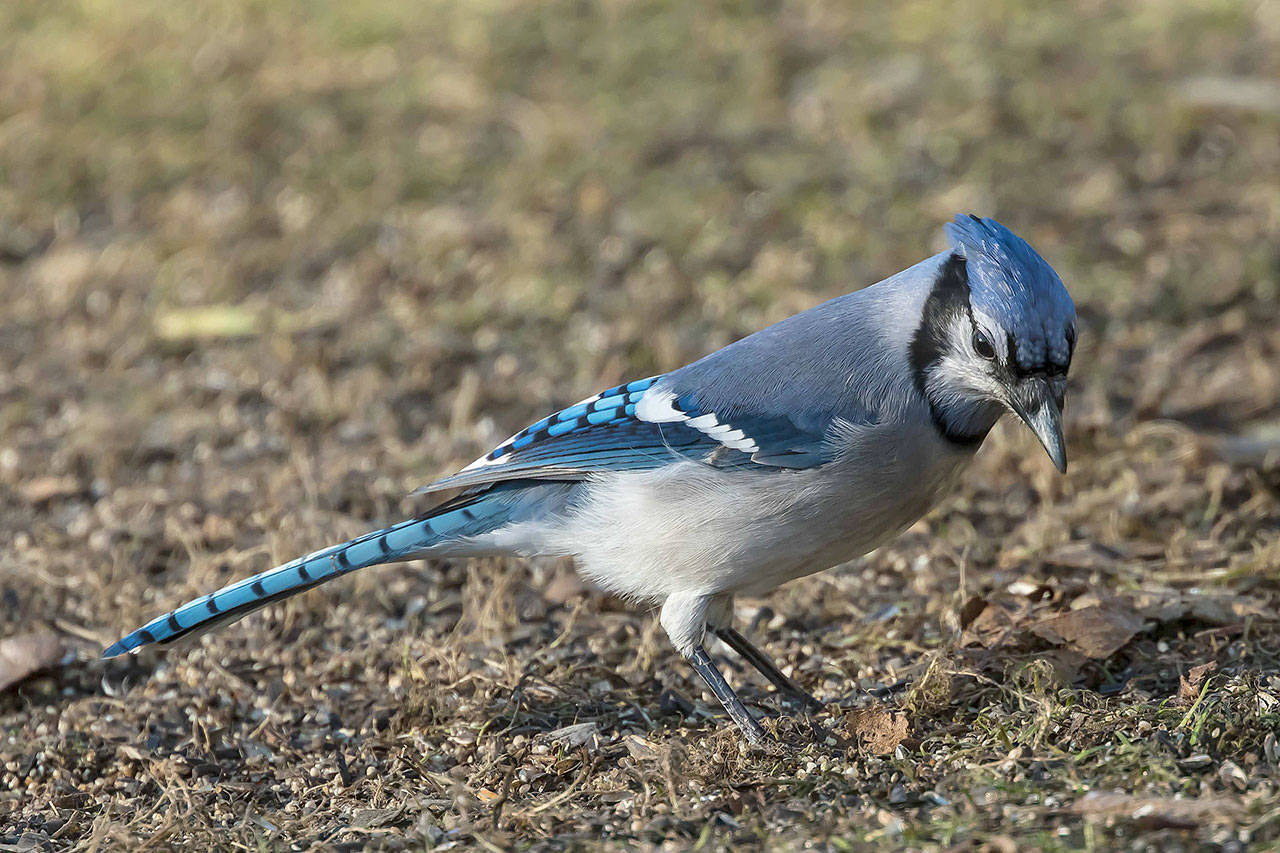By Dianna Moore
Grays Harbor Audubon
Many times I have been told by a non-birder that they have a “Blue Jay” coming to their feeders. I used to automatically correct them but rarely bother any more because they may have seen one after all! Blue Jays are moving into the Pacific Northwest, like their cousins, the California Scrub Jay. Where they used to be really rare west of the Cascades, we are beginning to see them more frequently. Luckily their coloration allows for a pretty easy identification, as shown in this excellent photo by Gregg Thompson.
General description: Blue Jays are about the size of a California Scrub Jay, about 10 to 12 inches in length, a wing span of 13 to 17 inches, and weighing approximately 2.5 to 3.5 ounces. They have a bright blue back and a white or gray belly and breast, a blue crest, a black necklace that encircles their neck and joins behind the crest. Their sturdy black bill is fairly short and straight, and a rounded blue tail with black stripes across it and white-tipped outer edges when seen in flight.Their blue wings are also barred with black and have one white wing-bar across each wing. Did I mention how noisy they are? They let the world know if a predator is around, so the unfortunate focus of attention doesn’t hang around very long…the jig’s up.
Habitat: Blue Jays are commonly found in the eastern half of the United States in mixed deciduous woods, back yards, and parks. They prefer to stay around the edges of their habitat, and stay away from pure conifer stands and deep forest. They are moving into the same sort of habitat in the west, and will no doubt continue to intrude on the territory of other jays.
Behavior: Like other corvids (crows, ravens, jays), Blue Jays are very vocal. They will definitely let everyone know when danger is near, but only defend their nest sites, not their whole territory. During nesting season and when robbing nests they can be very quiet to avoid detection. They can be found in loose flocks and are among the first to show up when an opportunity for food arises. They are doing so well out here because we have a lot of their favorite kinds of open spaces but lots of brush, deciduous trees, and seed-producing native plants. They are particularly fond of oak forests as their favorite food is acorns. They will usually cache any found for later consumption. Another reason for their success is how they dominate feeders, driving off the other birds, then taking (usually) black oiled sunflower seeds by the mouthful. They can empty a feeder in record time, especially if a whole flock finds the bounty. They have a wide repertoire of musical vocalizations and can easily mimic Red-tailed Hawks.
Diet: Blue Jays will eat almost anything. Nuts, seeds, and other vegetable matter make up the majority of their diet, but they also eat eggs and nestlings, invertebrates, small rodents, frogs, and carrion.
Nesting: Blue Jays form monogamous pairs and stay together year-round. Both help build the nest on a horizontal limb or the vertical crotch of a tree. It is a bulky cup of broken-off fresh twigs, with grass, moss, bark, lichen, and leaves, sometimes held together with mud. It is usually lined with rootlets, dried grasses, moss, and other fine materials, and is often decorated on the outside with paper, string, or other light-colored material. The female typically incubates 4-6 eggs for 17-18 days. Both members of the pair feed the young, which leave the nest at 17-21 days and spend their first few days out of the nest in nearby branches before fledging.
Migration: Blue Jays don’t really migrate but are known to move around from sea level to mountainous terrain. Some birds of the northern reaches migrate farther south, but this needs more study to understand the dynamics of their movement.
Conservation status: Blue Jays are well-adapted to living with humans and take advantage of the increasing edge habitat created by suburban development. These jays are common throughout their range (which has not included Washington until recently), and they are expanding into the Northwest. This expansion has been attributed to urbanization, feeding stations, and population increases to the northeast, in Canada. Blue Jays have become more and more regular in Washington within the past 20 years, including some invasion years with multiple birds sighted.
When and where to find on Grays Harbor: Blue Jays are rare fall and winter visitors in Washington. A few birds have reached the western Washington lowlands, and even the outer coast, so they will soon be appearing at a backyard feeder station near you…keep your eyes open. But remember, before they show up in numbers, learn to differentiate them from their other cousins. Meanwhile, I’ll pay more attention to reports of local sightings of “Blue Jays” — they are definitely on their way.


